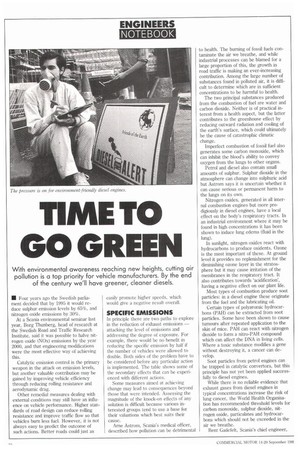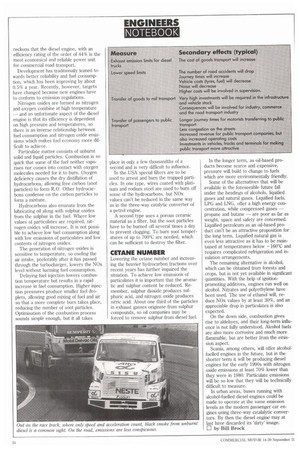TIME TO GO GREEN
Page 34

Page 36

If you've noticed an error in this article please click here to report it so we can fix it.
• Four years ago the Swedish parliament decided that by 1995 it would reduce sulphur emission levels by 65%, and nitrogen oxide emissions by 30%.
At a Scania environmental seminar last year, Borg Thunberg, head of research at the Swedish Road and Traffic Research Institute, said it was possible to halve nitrogen oxide (N0x) emissions by the year 2000, and that engineering modifications were the most effective way of achieving this.
Catalytic emission control is the primary weapon in the attack on emission levels, but another valuable contribution may be gained by improving vehicle efficiency through reducing rolling resistance and aerodynamic drag.
Other remedial measures dealing with external conditions may still have an influence on vehicle performance. Higher standards of road design can reduce rolling resistance and improve traffic flow so that vehicles burn less fuel. However, it is not always easy to predict the outcome of such actions. Better roads could just as
easily promote higher speeds, which would give a negative result overall.
SPECIFIC EMISSIONS
In principle there are two paths to explore in the reduction of exhaust emissions — attacking the level of emissions and addressing the degree of exposure. For example, there would be no benefit in reducing the specific emission by half if the number of vehicles were allowed to double. Both sides of the problem have to be considered before any particular action is implemented. The table shows some of the secondary effects that can be experienced with different actions.
Some measures aimed at achieving change may lead to consequences beyond those that were intended. Assessing the magnitude of the knock-on effects of any solution is difficult because various interested groups tend to use a base for their valuations which best suits their cause.
Arne Astrom, Scania's medical officer, described how pollution can be detrimental
to health. The burning of fossil fuels contaminate the air we breathe, and while industrial processes can be blamed for a large proportion of this, the growth in road traffic is making an ever-increasing contribution. Among the large number of substances found in polluted air, it is difficult to determine which are in sufficient concentrations to be harmful to health.
The two principal substances produced from the combustion of fuel are water and carbon dioxide. Neither is of practical interest from a health aspect, but the latter contributes to the greenhouse effect by reducing outward radiation and cooling of the earth's surface, which could ultimately be the cause of catastrophic climatic change.
Imperfect combustion of fossil fuel also generates some carbon monoxide, which can inhibit the blood's ability to convey oxygen from the lungs to other organs.
Petrol and diesel also contain small amounts of sulphur. Sulphur dioxide in the atmosphere can change into sulphuric acid but Astrom says it is uncertain whether it can cause serious or permanent harm to the lungs on its own.
Nitrogen oxides, generated in all internal combustion engines but more prodigiously in diesel engines, have a local effect on the body's respiratory tracts. In an industrial environment where it may be found in high concentrations it has been shown to induce lung edema (fluid in the lung).
In sunlight, nitrogen oxides react with hydrocarbons to produce oxidents. Ozone is the most important of these. At ground level it provides no replenishment for the diminishing ozone layer in the stratosphere but it may cause irritation of the membranes in the respiratory tract. It also contributes towards 'acidification', having a negative effect on our plant life.
Most types of combustion produce soot particles: in a diesel engine these originate from the fuel and the lubricating oil.
Certain types of polyaromic hydrocarbons (PAR) can be extracted from soot particles. Some have been shown to cause tumours after repeated application to the skin of mice. PAH can react with nitrogen dioxide to form a nitro-PAH compound which can affect the DNA in living cells. Where a toxic substance modifies a gene without destroying it, a cancer can develop.
Soot particles from petrol engines can be trapped in catalytic convertors, but this principle has not yet been applied successfully to diesel engines.
While there is no reliable evidence that exhaust gases from diesel engines in typical concentrations increase the risk of lung cancer, the World Health Organisation has recommended threshold levels for carbon monoxide, sulphur dioxide, nitrogen oxide, particulates and hydrocarbons which should not be exceeded in the air we breathe.
Bent Gadefelt, Scania's chief engineer, reckons that the diesel engine, with an efficiency rating of the order of 44% is the most economical and reliable power unit for commercial road transport.
Development has traditionally leaned towards better reliability and fuel consumption, which has been improving by about 0.5% a year. Recently, however, targets have changed because new engines have to conform to emission regulations.
Nitrogen oxides are formed as nitrogen and oxygen combine at high temperature — and an unfortunate aspect of the diesel engine is that its efficiency is dependent on high pressure and temperatures, so there is an inverse relationship between fuel consumption and nitrogen oxide emissions which makes fuel economy more difficult to achieve.
Particulate matter consists of unburnt solid and liquid particles, Combustion is so quick that some of the fuel neither vaporises nor comes into contact with oxygen molecules needed for it to burn. Oxygen deficiency causes the dry distillation of hydrocarbons, allowing free carbon (soot particles) to form R.O. Other hydrocarbons condense on the carbon particles to form a mixture.
Hydrocarbons also emanate from the lubricating oil along with sulphur oxides from the sulphur in the fuel. Where low values of particulates are required, nitrogen oxides will increase. It is not possible to achieve low fuel consumption along with low emissions of particulates and low contents of nitrogen oxides.
The generation of nitrogen oxides is sensitive to temperature, so cooling the air intake, preferably after it has passed through the turbocharger, lowers the NOx level without harming fuel consumption.
Delaying fuel injection lowers combustion temperature but results in a rapid increase in fuel consumption. Higher injection pressures produce smaller fuel droplets, allowing good mixing of fuel and air so that a more complete burn takes place, reducing the number of soot particles. Optimisation of the combustion process sounds simple enough, but it all takes place in only a few thousandths of a second and is very difficult to influence.
In the USA special filters are to be used to arrest and burn the trapped particles. In one type, wires coated with platinum and rodium steel are used to burn off some of the hydrocarbons, but NOx values can't be reduced in the same way as in the three-way catalytic converter of a petrol engine.
A second type uses a porous ceramic material as a filter, but the soot particles have to be burned off several times a day to prevent clogging. To burn soot temperatures of up to 700°C are needed, which can be sufficient to destroy the filter.
CETANE NUMBER
Lowering the cetane number and increasing the heavier hydrocarbon fractions over recent years has further impaired the situation. To achieve low emissions of particulates it is important that the aromatic and sulphur content be reduced. Remember, sulphur dioxide produces sulphuric acid, and nitrogen oxide produces nitric acid. About one third of the particles in exhaust gasses originate from sulphur compounds, so oil companies may be forced to remove sulphur from diesel fuel. In the longer term, as oil-based products become scarce and expensive, pressure will build to change to fuels which are more environmentally friendly.
Some of the alternatives that will be available in the foreseeable future fall under the headings of alcohols, liquffied gases and natural gases. Liquified fuels, LPG and LNG, offer a high energy concentration, while compressed gases — propane and butane — are poor as far as weight, space and safety are concerned. Liquified petroleum as an oil-based product can't be an attractive proposition for the long term. Liquified natural gas is even less attractive as it has to be maintained at temperatures below —160°C and requires complicated refrigeration and insulation arrangements.
The remaining alternative is alcohol, which can be obtained from forests and crops, but is not yet available in significant quantities. With the help of ignitionpromoting additives, engines run well on alcohol. Nitrates and polyethylene have been used. The use of ethanol will, reduce NOx values by at least 30%, and an appreciable drop in particulates is also expected.
On the down side, combustion gives rise to aldehyes, and their long-term influence is not fully understood. Alcohol fuels are also more corrosive and much more flammable, but are better from the emission aspect.
Scalia, among others, will offer alcoholfuelled engines in the future, but in the shorter term it will be producing diesel engines for the early 1990s with nitrogen oxide emissions at least 70% lower than they were in 1980. Particulate emissions will be so low that they will be technically difficult to measure.
In urban areas, buses running with alcohol-fuelled diesel engines could be made to operate at the same emission levels as the modern passenger car engines using three-way catalalytic convertors. By then the diesel engine may at last have discarded its 'dirty' image. LI by Bill Brock






















































































































































